Day 1 of a long weekend of tours today, and we headed up towards the NW Norfolk coast. There had been a frost overnight, pretty much the first we have had this winter, and the day dawned beautifully bright and sunny.
We stopped at Holkham briefly on our way. It was a great view looking out across the grazing marshes. Several large groups of Pink-footed Geese were flying up from the grass and heading off inland to feed. Their yelping calls are such a sound of Norfolk in the winter.
Closer to us, on the near side of the marshes we could immediately see a few White-fronted Geese, the white blaze around the base of their bills really catching the morning light. We quickly got the scope on them for a closer look before realising that there were actually a lot more of them further along, just beyond the hedge. We could see the distinctive black belly bars of the adults.
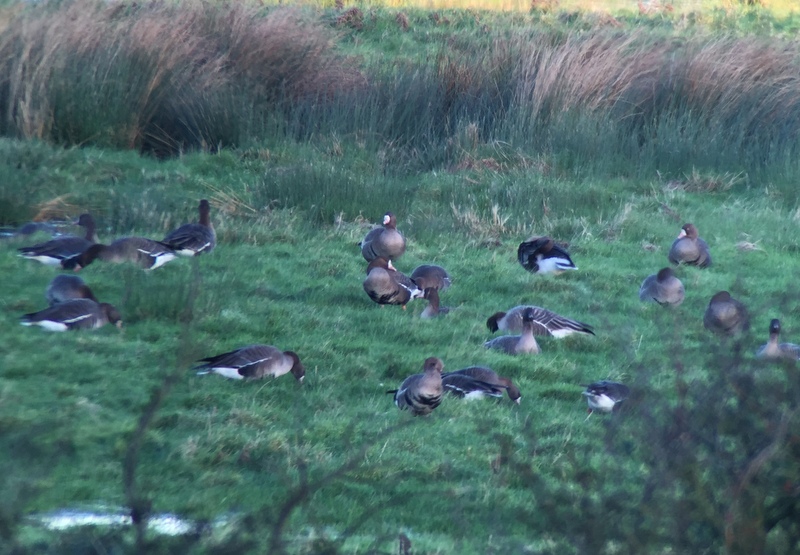 White-fronted Geese – very good numbers at Holkham today
White-fronted Geese – very good numbers at Holkham today
There seemed to be more today than we have seen here so far this winter, certainly well over 100. It is possible that increasingly cold weather on the continent is finally pushing some more wildfowl to make the journey across the North Sea. As we were to see later in the day, some birds are definitely on the move.
We headed inland from here to continue on our way west. We had hoped to stumble upon one of the Rough-legged Buzzards which have been lingering in the area for a few weeks now, but unfortunately there was no sign this morning. The fields around Choseley were full of Brown Hares, and a couple even indulged in a very brief boxing bout. With all the mild weather of late, perhaps they think spring is around the corner.
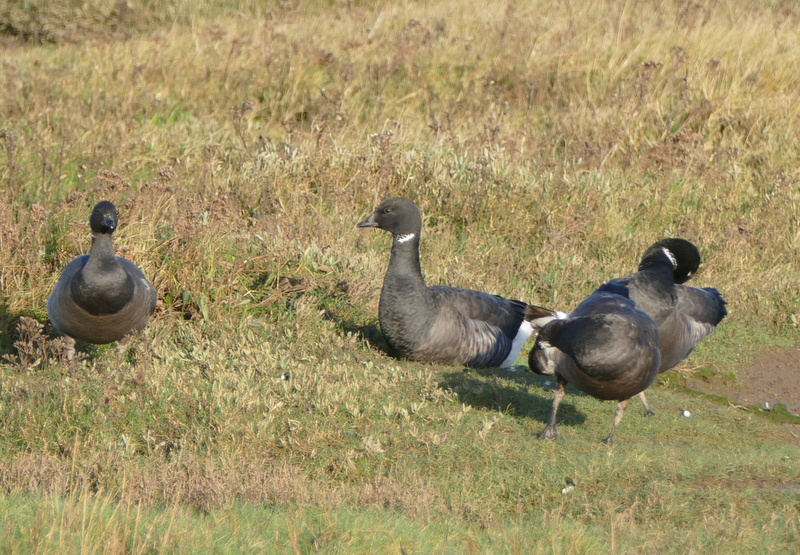 Brent Geese – loafing around the car park at Thornham again
Brent Geese – loafing around the car park at Thornham again
Our next stop proper was at Thornham Harbour. A small group of Brent Geese were loafing around in the car park, preening. They seem to like this spot. A few Curlew and Redshank were in the muddy creeks.
We had not even got to the bridge when we heard the Twite approaching – their buzzy flight calls are really distinctive – and a flock of about 30 hove into view. Unfortunately, they were really flighty and wouldn’t settle for any length of time, at one point landing not far in front of us, but taking off again immediately.
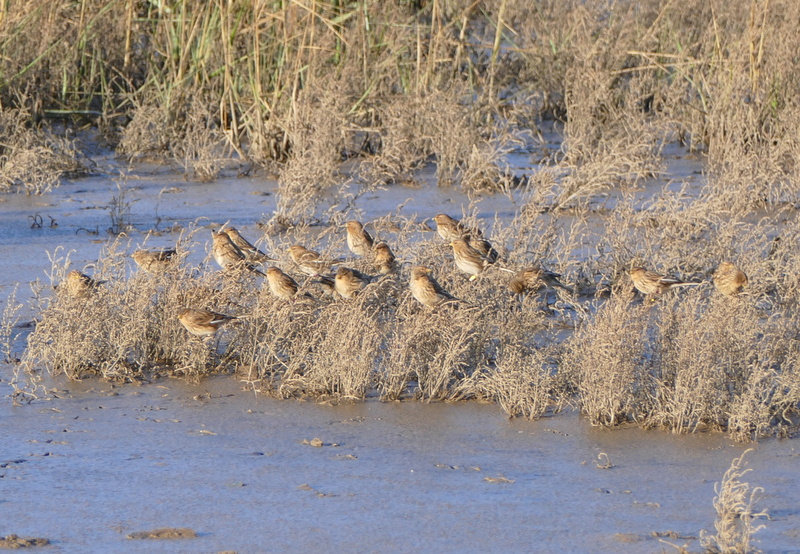 Twite – the flock at Thornham was very flighty today
Twite – the flock at Thornham was very flighty today
They flew off over the seawall and seemed to go down on the other side, so we climbed up onto the path and set off in pursuit. The Twite were feeding on the edge of the saltmarsh below the path, but once again would not sit still. Eventually they came towards us and landed nearby – we got the scope on them and all had a good look, but wouldn’t stay for a photo and took off as soon as we lined up the camera! Still, it was good to see their yellow bills and peachy orange washed breasts.
There was also a pair of very obliging Stonechats along the edge of the path, which worked their way along in front of us. A large flock of Lapwing came in from the direction of the beach and headed off west, presumably new arrivals from the continent for the winter. We made our way round and out onto the beach.
We could see the Shore Larks on the edge of the dunes as we approached. A photographer lying prone on the sand gave their position away! We were looking into the sun but had a quick look through the scope in case they flew off, before making our way round to the other side round via the beach. At that moment, someone walked up over the dunes behind and they flew off, but thankfully landed again on the beach. This time we could get a much better look at them.
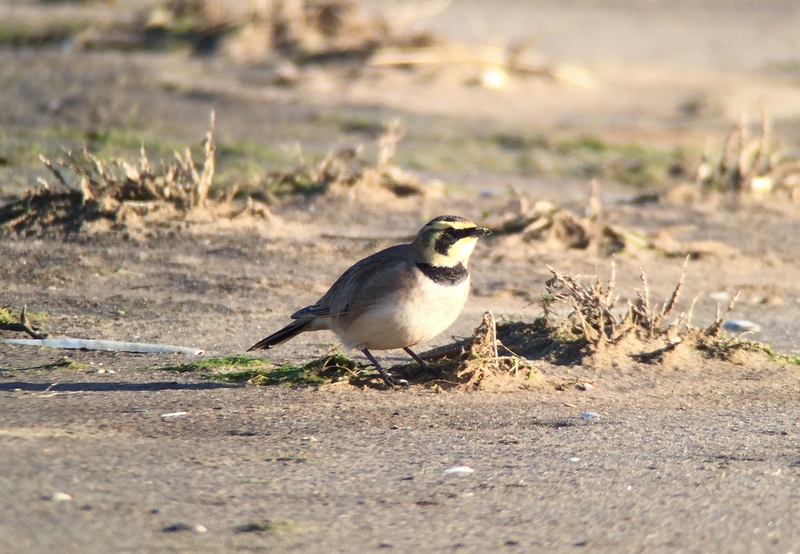 Shore Lark – the better marked of the three, presumably the male
Shore Lark – the better marked of the three, presumably the male
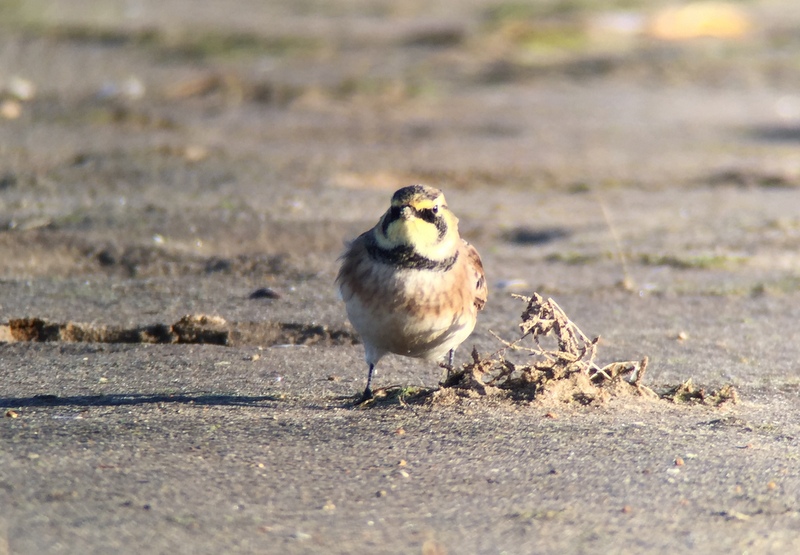 Shore Lark – one of the others, with stronger breast markings
Shore Lark – one of the others, with stronger breast markings
We watched the Shore Larks for some time, scuttling about, picking at the few tufts of dried out vegetation. Their yellow faces shone in the sunlight. A scan of the beach beyond yielded a smart adult Peregrine perched on something on the sand. Then we made our way back along the beach.
We stopped again by the path over the dunes and had a look out at the sea. A Fulmar glided past lazily and a Red-throated Diver flew through. Most of the ducks are feeding a long way offshore – we could see a vast raft of Common Scoter out towards the wind farm, hundreds of ducks although it was hard to see how many at that distance among the waves.
While we were looking at the scoter, two much larger white shapes drifted past. They were swans out on the sea and, zooming up the scope, we could see that they were Bewick’s Swans. Wintering numbers of Bewick’s Swans here have been down on previous years so far this winter. They normally break their journey from Russia on the continent and may remain there if the weather is mild – again, it may be that colder weather there is finally going to boost the totals here. The two swans were obviously just having a breather on their long journey and soon took off and flew in towards Holme.
We made our way round to Titchwell next. We decided to have an early lunch first before heading off onto the reserve. Several Long-tailed Tits were feeding around the car park. A Siskin flew in and landed in the trees above the cars with a group of Goldfinches, its yellow breast catching the sun. We could just hear a Bullfinch calling, but it remained deep in the bushes out of sight. The feeders around the Visitor Centre were also full of finches. Amongst the Chaffinches in the tree behind, we found a single Brambling.
When we got to the main path, we made sure we had a good look in the ditches either side. It didn’t take long to find a Water Rail scuttling along in the water in the bottom. It found a quiet corner and started to bathe, before disappearing into the reeds to preen.
Out at the grazing marsh pool, several pipits flew round just as we arrived but landed out of sight behind the reeds. A Rock Pipit emerged briefly into the open, before disappearing again. We walked a bit further along and, looking back, we could just see three pipits out on the mud. Two were Rock Pipits – swarthy, oily coloured with heavily streaked, dirty underparts. The third was much paler, cleaner white below with more restricted black breast streaking and a clearer pale supercilium – a Water Pipit. It was great to see the two species side by side.
 Gadwall – a beautiful, subtly patterned drake
Gadwall – a beautiful, subtly patterned drake
We called in at Island Hide next to have a good look out at the freshmarsh. The water levels are still high, which is good for the ducks. There were lots of Teal, Gadwall, Wigeon and Shoveler. Further over, we could see a few Pintail, including several very smart drakes. We spent some time admiring the drake Gadwall, a most under-rated duck with subtly patterned plumage, unlike some of the other gaudy species. The drake Teal were looking very smart too! A large flock of Brent Geese dropped into the freshmarsh to bathe before flying back off towards the saltmarsh to feed.
 Teal – also a very smart duck when seen up close
Teal – also a very smart duck when seen up close
There are not so many waders on the freshmarsh at the moment. A hardy group of Avocets is hanging on – they were mostly asleep, in the shallow water around one of the small remaining islands. Several little groups of Dunlin were running around on the available areas of mud, in between a few Lapwing. Apart from the wildfowl, the highlight out here was a single adult Yellow-legged Gull which was standing around with a few Black-headed Gulls.
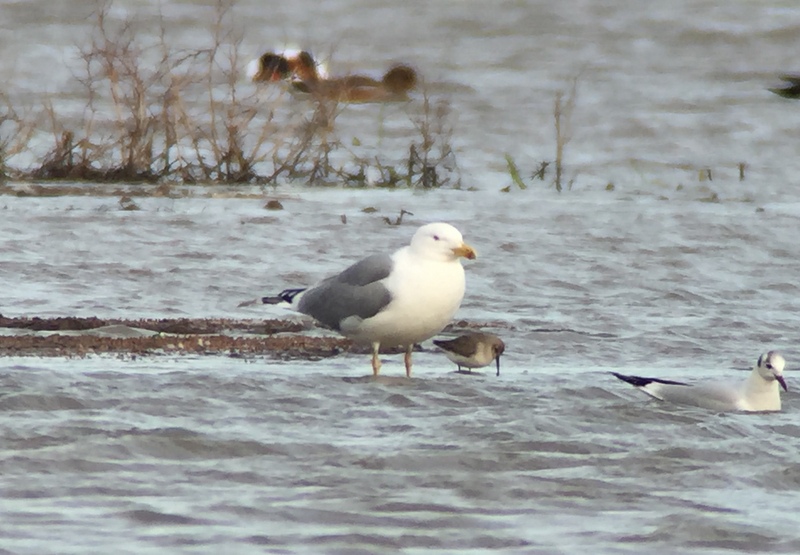 Yellow-legged Gull – this adult was on the freshmarsh all afternoon
Yellow-legged Gull – this adult was on the freshmarsh all afternoon
With the forecast suggesting a risk of showers this afternoon – though we didn’t actually see one in the end – we headed straight out towards the beach from Island Hide. There were a few more waders on the Volunteer Marsh – lots of the usual Curlew and Redshank, plus a couple of obliging Black-tailed Godwits by the path. We stopped to watch a small group of Knot which flew round and landed in one of the pools, with a couple of Dunlin to provide a useful size comparison. Even in winter plumage, Grey Plover are very smart waders up close – through the scope we admired their white-spangled upperparts.
 Black-tailed Godwit – feeding by the path on the Volunteer Marsh
Black-tailed Godwit – feeding by the path on the Volunteer Marsh
Out on the tidal pools, there were several Bar-tailed Godwits today feeding around the islands which the Black-tailed Godwits favour. We got a good view of the Bar-taileds and even had the two species side-by-side at one point, giving a great comparison. A group of Oystercatchers were roosting on here and a couple of Ringed Plover were running around on the mud but there was no sign of the Spotted Redshank today. Several Little Grebes and three female Goldeneye were all diving constantly.
Out on the beach, the tide was coming in. There were several silvery-white Sanderling scurrying about in front of the waves and over towards Thornham Point, the Bar-tailed Godwits had gathered in big gangs.
Looking out to sea, most of the duck were very distant, as they had been at Holme. A vast flock of Common Scoter took off and circled around right out on the horizon to the west, presumably the same ones we had seen earlier. Out in front of us, a handful of Common Scoter were a bit closer so we could get them in the scope – we could even see the yellow bill stripe on the otherwise black drakes as they caught the sun. A spiky-haired drake Red-breasted Merganser was wrestling with a large fish offshore.
As we turned to go, all the Bar-tailed Godwits took off and whirled round over first the sea and then the beach before flying over our heads and dropping down towards the tidal pools. When we got back there, they had all landed with the roosting Oystercatchers. As we walked back past the Volunteer Marsh, we heard a Spotted Redshank calling out over the saltmarsh towards Thornham.
 Bar-tailed Godwits & Oystercatchers – roosting over high tide
Bar-tailed Godwits & Oystercatchers – roosting over high tide
We called in at the Parrinder Hide on the way back. There were some nice close Wigeon just below the hide and, in amongst them on the edge of the water, was a single Common Snipe. It was remarkably well camouflaged in the cut reed stems and rushes. It ran up onto the bank and started to probe vigorously into the grass.
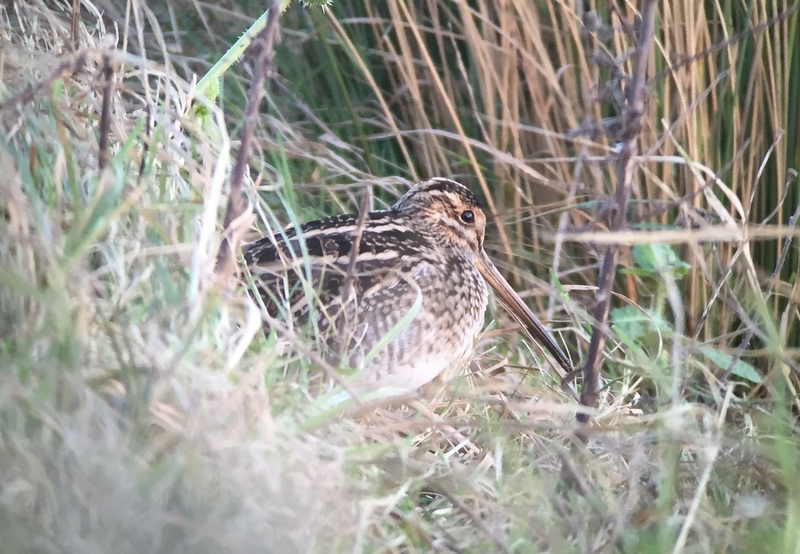 Snipe – feeding on the bank below the Parrinder Hide
Snipe – feeding on the bank below the Parrinder Hide
There were many more gulls out on the freshmarsh now, with waves of birds dropping in before going to roost. The Yellow-legged Gull, now asleep, was still in among them. At the back, over the reedbed, several Marsh Harriers were now circling. On one of the islands, a succession of Cormorants flew in and landed. The light was fading and bedtime was approaching!
We made our way back to the car. As we walked down the main path, five more swans came overhead, heading west into the setting sun. More Bewick’s Swans, they were definitely on the move today. We stopped for a second and we were overtaken by some other local birders who were off in a hurry. They told us the reason – the Red-necked Grebe which had been in the harbour channel at Brancaster Staithe before Christmas had returned. It was on our way home, so it would have been churlish not to call in.
 Brancaster Staithe – looking for the Red-necked Grebe at dusk
Brancaster Staithe – looking for the Red-necked Grebe at dusk
Dusk was descending by the time we arrived and caught up with the others. The Red-necked Grebe was out in the harbour, among the buoys. It was not the best view in the last of the light, but it was a good way to end the day anyway.
 Red-necked Grebe – taken at Brancaster Staithe before Christmas
Red-necked Grebe – taken at Brancaster Staithe before Christmas
















